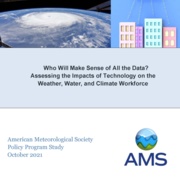Executive Summary
Rapid technological development is a powerful driver of change across the whole of society. Within the weather, water, and climate (WWC) enterprise, technological shifts have enabled advances in observations and research that expand scientific capabilities and understanding. These shifts have in turn touched nearly every aspect of the WWC workforce, from the availability of workers to the skills that they need. Moreover, changes in technology will almost certainly continue to alter challenges and opportunities within the WWC workforce in the decades to come.
This AMS Policy Program study explores the state of the technological landscape in WWC science and its implications for employers and employees across the public, private, and academic sectors. Synthesizing the perspectives of experts throughout the WWC enterprise, along with additional analysis, we detail the opportunities and challenges for workforce adaptation that are required as a result of technological advancement. Additionally, we discuss frameworks to support the current and future workforce across all career levels within the enterprise.
We find two major technological drivers of WWC science: ever-increasing data availability and advancing computing capacity. The former stems largely from the proliferation of improved sensor technologies and networks, along with small satellites; the latter from specialized computer chips and cloud resources. These developments have spurred the uptake of artificial intelligence and machine learning as well as a shift in the dominant programming language within the workforce.
In response to the increasing variety of programs and systems enabling work with data, skills such as data management and the ability to problem solve and think at a systems level are likely to be broadly applicable to WWC science. The continual development of new technologies will likely also favor personal adaptability and flexibility that allows lifelong learning with the ability to quickly adopt new tools. Competition within and beyond the enterprise for employees with these skill sets presents a clear challenge for employers and raises many questions regarding the future of the WWC workforce.
Potential frameworks to address these technological challenges and questions include a conscious push to improve communication and collaboration across sectors as well as a renewed approach to education for early as well as mid- and late-career individuals.
We identify six overarching concepts that underpin further efforts to advance the WWC workforce:
- Needs emerging from the rapid advance of data and computing capacity are strong technological drivers on the WWC workforce.
- Technological change will be rapid but not uniform in its impact on the workforce: differences may be reflected in field of expertise or career stage.
- The enterprise must holistically consider the appropriate use and support of technologies such as cloud computing and artificial intelligence, while maintaining flexibility as new tools emerge.
- Technical mindsets integrating data management and systems-level thinking are likely to be broadly applicable in the long term.
- The rapid introduction of new tools demands a renewed approach to education and training that encompasses multiple disciplines and stages of career development; cross-sector partnerships are vital to these efforts.
- Multiple approaches are possible to address challenges; solutions may be blended to enable the most optimal outcomes for individuals, organizations, and the enterprise as a whole.
AMS is engaged in multiple ongoing efforts to better understand workforce challenges and opportunities in order to help meet the future needs of the enterprise and support the careers of all enterprise members.
